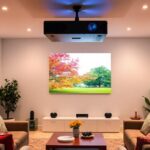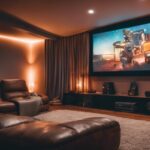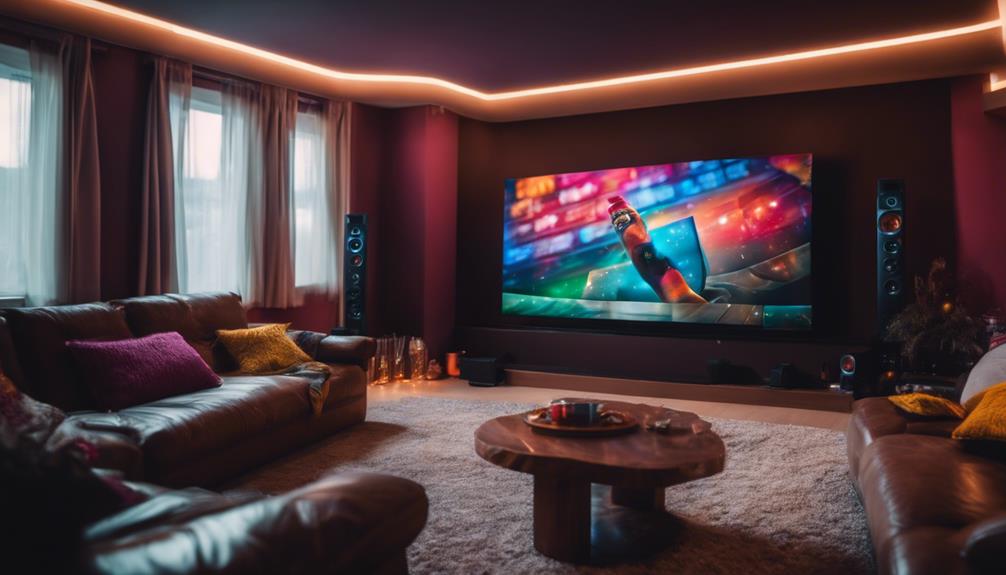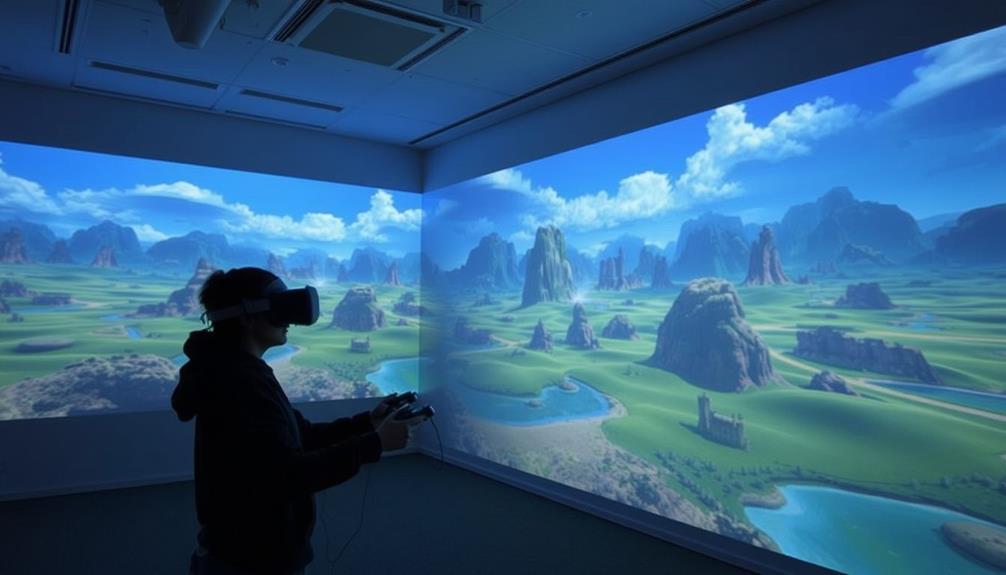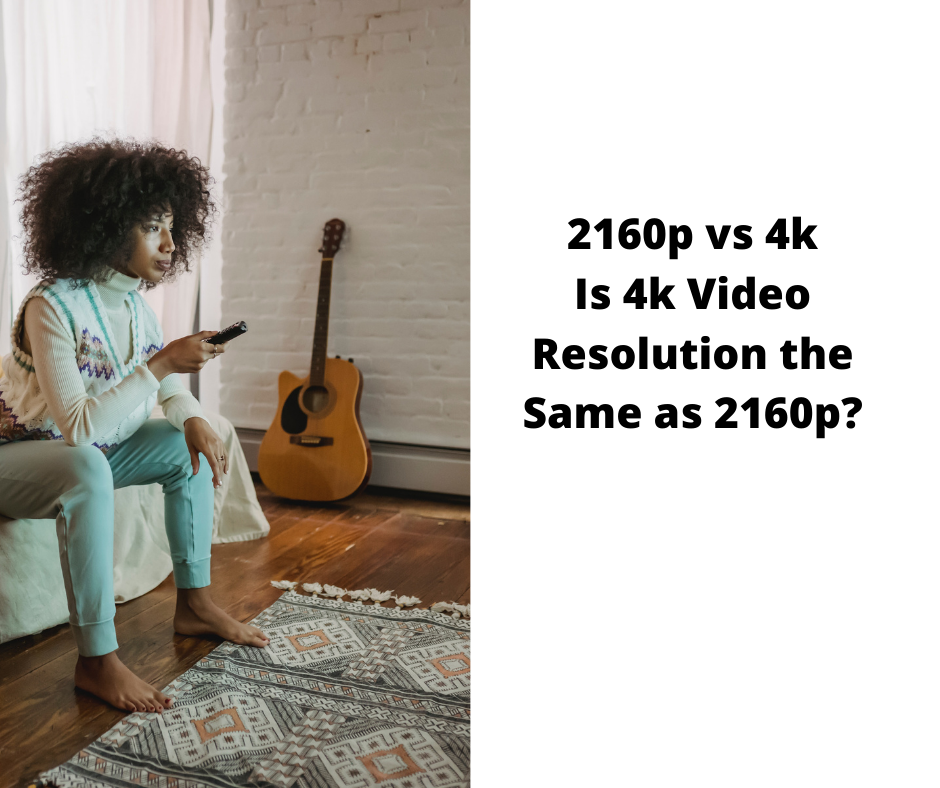To choose the perfect projector for your home cinema, start by evaluating your needs, like movie nights or gaming. Look for a projector with at least 1080p resolution and 2,500 ANSI lumens for bright rooms or 2,000 for darker settings. Set a budget between $1,500 and $2,000 for quality options. Consider projector types—home theater, business, or portable—based on your space. Don't forget about connectivity; multiple HDMI ports and wireless options enhance versatility. Finally, enhance your experience with a good audio system. You'll discover even more tips and insights to refine your choice.
Key Takeaways
- Assess your primary usage needs, such as movie nights or gaming, to determine the right projector type.
- Ensure the projector has at least 1080p resolution and a minimum brightness of 2,500 ANSI lumens for optimal viewing.
- Consider throw distance; standard-throw projectors require more distance than short-throw projectors to display larger images.
- Evaluate connectivity options, including multiple HDMI ports and built-in wireless capabilities, for seamless device integration.
Determine Your Projector Needs
When choosing a projector, you should first assess your specific needs based on how you plan to use it, whether for movie nights, gaming, or presentations.
If you're aiming for a home theater setup, you'll want a projector that offers high resolution and brightness to guarantee a cinematic experience. For dark environments, look for at least 2,000 lumens; however, if your space has ambient light, aim for 3,000 lumens or more to achieve clear images.
Next, consider the throw distance and screen size. Standard-throw projectors typically need 8-10 feet to project a 100-inch image, while short-throw models can be placed much closer. This decision will affect your room layout and overall viewing experience.
Additionally, explore various projection technologies, like lamp versus laser models. Laser projectors may have a higher upfront cost but offer longer lifespans and enhanced performance.
Set Your Budget
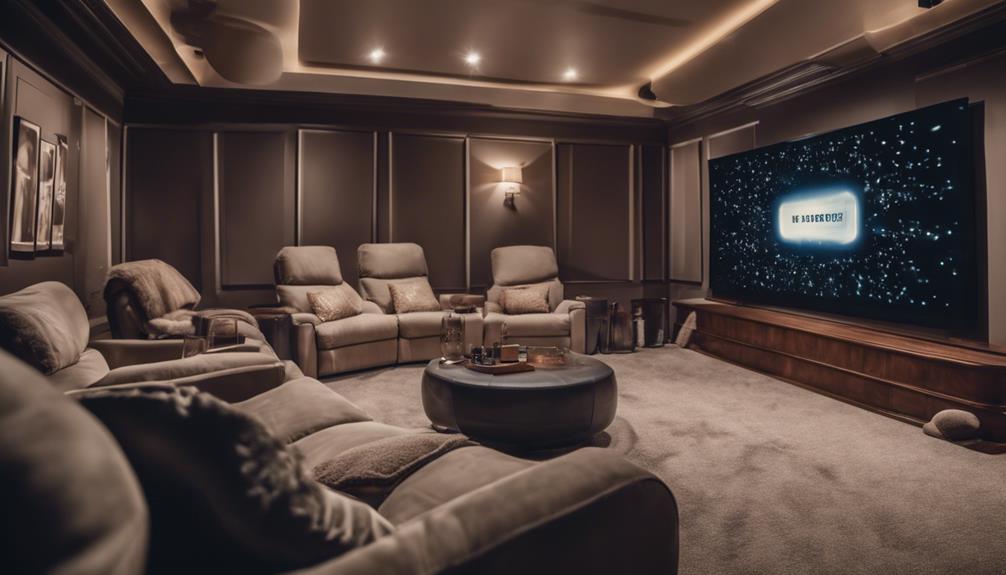
Setting a budget for your projector is vital to guarantee you get the best home cinema experience without overspending. Quality options typically range from $1,500 to $2,000, offering a solid foundation for your home theater.
However, it's essential to take into account additional costs, like projector screens, sound systems, and mounts, which can greatly influence your overall investment. Projectors can vary widely in price, starting around $600 for basic models and exceeding $3,000 for high-end options.
Identify the features most important to you, so you don't waste money on unnecessary extras. Keep an eye out for current projector deals, as these can provide considerable savings and allow you to enhance your setup within your budget.
If finances are tight, prioritize budget-friendly accessories that can complement your projector without breaking the bank. By being strategic about your choices, you can still achieve a satisfactory home cinema experience.
Explore Projector Types
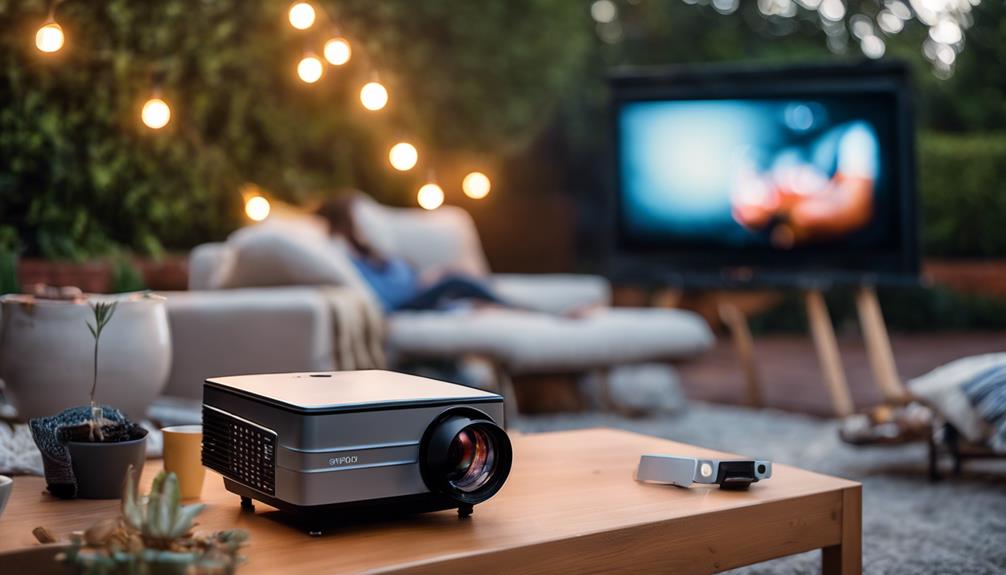
When choosing the right projector for your home cinema, it's essential to understand the various types available.
Home theater projectors offer high resolution for an immersive experience, while business projectors cater to bright environments but lack cinematic quality.
If you're looking for flexibility, portable projectors can bring the movie experience outdoors, though they mightn't match the performance of dedicated models.
Home Theater Projectors
Home theater projectors come in various types, each designed to enhance your viewing experience in different home environments. When choosing the right projector, consider the following factors:
- Projector Resolution: Aim for at least 1080p or 4K resolution to achieve stunning image quality. Higher resolutions guarantee better detail and clarity in your movies or games.
- High Brightness: For rooms with ambient light, look for projectors with at least 2,500 ANSI lumens. This brightness level helps maintain vivid colors and contrast on your projector screens, even in less-than-ideal lighting.
- Laser Projector vs. Lamp-Based: Laser projectors offer better color accuracy and longer lifespans, lasting up to 30,000 hours. In contrast, lamp-based models require more maintenance and replacement, usually lasting only 2,000 to 5,000 hours.
Additionally, consider the distance needed for a standard throw versus a short throw projector. Short throw projectors are perfect for smaller spaces, allowing you to enjoy a large image without needing to sit far away.
Confirm your projector has multiple HDMI inputs for convenient connectivity with your devices.
Business Projectors Overview
Business projectors are vital tools for professionals, designed to deliver clear presentations in brightly lit environments. With brightness levels of 3000 lumens or more, these projectors guarantee your visuals remain sharp and vibrant even in well-lit conference rooms or offices.
Many models utilize DLP technology, which not only provides smooth motion but also keeps the design lightweight for easy transport between locations.
When planning your setup, keep in mind that standard-throw business projectors usually need a distance of 8 to 10 feet to project a 100-inch image. This requires careful consideration of room layout and seating arrangements to maximize your audience's viewing experience.
Connectivity options are essential for seamless integration, and most business projectors come equipped with HDMI inputs, VGA, and USB ports. This versatility allows you to connect various devices, including laptops and document cameras, without hassle.
While business projectors prioritize static image quality, making them ideal for presentations, they may not perform as well with high-motion content like movies or gaming. By understanding these features, you'll choose a projector that meets your professional needs effectively.
Portable Projector Options
After exploring the features of business projectors, it's time to reflect on portable projector options that offer flexibility and convenience for casual viewing in various settings. These projectors are compact and lightweight, making them easy to transport, but they usually compromise on brightness and advanced features compared to dedicated home theater systems.
Here are three key aspects to take into account when choosing a portable projector:
- Brightness: Most portable projectors have lower brightness outputs, typically around 300 ANSI lumens, making them more suitable for darker environments.
- Streaming Capabilities: Many models, like the Xgimi MoGo 2, come with built-in streaming capabilities, enhancing their versatility for enjoying movies or presentations without extra devices.
- Image Quality: While they can provide decent image quality for casual viewing, they may not meet the high-resolution demands of a dedicated home theater setup.
Ultimately, if you're looking for a versatile option for outdoor movie nights or travel, portable projectors can be a great choice, even though they may not match the performance of higher-end models.
Evaluate Light Sources

When choosing a projector, you need to contemplate how much ambient light your space has and how bright the projector needs to be for ideal viewing.
Different light sources can greatly impact the image quality, especially in a home cinema setting.
Understanding these factors will help you make an informed decision that suits your viewing environment.
Ambient Light Control
Evaluating light sources in your home cinema is fundamental, as ambient light control directly impacts the quality of your projected image. To guarantee you achieve the best projector performance, consider these factors:
- Room Environment: Darker rooms provide superior image quality compared to well-lit spaces. If your room has many windows or bright artificial lighting, it may create glare, diminishing your viewing experience.
- Brightness Rating: For ideal performance, projectors for bright rooms should have a brightness rating of at least 2,500 ANSI lumens. In contrast, those for darker environments perform best with over 2,000 lumens.
- Screen Type: Using ambient light rejecting (ALR) screens can substantially enhance picture quality. These screens reflect more light from the projector while minimizing reflections from surrounding light sources, improving your viewing experience.
Additionally, keep in mind the projector's throw distance. Long-throw models can be challenging in brightly lit spaces, so it's vital to calculate the distance from the screen accurately.
Brightness Requirements
To achieve the best viewing experience in your home cinema, understanding brightness requirements based on your room's lighting is key. The brightness of your projector, measured in ANSI lumens, directly impacts visibility, clarity, and color accuracy. Here's a quick guide to help you choose the right projector for your viewing environment:
| Viewing Environment | Recommended ANSI Lumens | Ideal Screen Type |
|---|---|---|
| Dark Room | 2000+ | Standard Screen |
| Standard Lighting | 1000+ | Standard or ALR Screen |
| Bright Room | 3000+ | Ambient Light Rejecting Screen |
| Casual Viewing (Portable) | 300 | Portable Screen |
| Mixed Lighting | 2500+ | ALR Screen |
For a 100-inch screen, you'll want a minimum of 1,000 ANSI lumens for adequate visibility. In well-lit rooms, opt for projectors with 2,500+ lumens and ALR screens to enhance image quality. Remember, the right brightness requirements will guarantee your images pop, maintaining clarity and color accuracy, regardless of ambient light.
Assess Brightness and Resolution
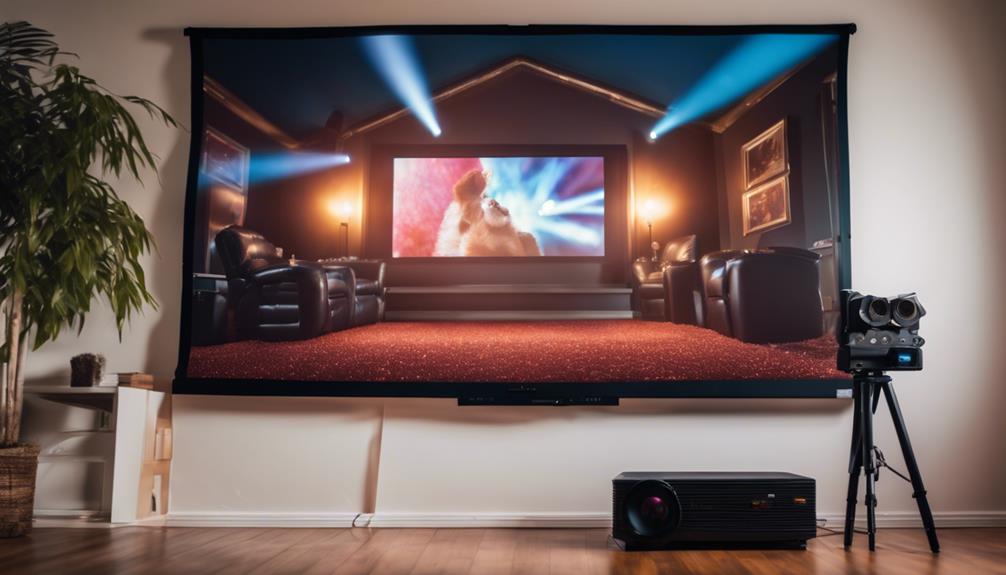
Evaluating brightness and resolution is essential for guaranteeing your projector delivers a stunning home cinema experience. Brightness, measured in ANSI lumens, directly affects how well your projector performs in various lighting conditions. For a 100-inch screen in a dark room, aim for at least 1,000 ANSI lumens. If you're in a bright environment, look for projectors with 2,500 to 3,000 lumens.
When it comes to resolution, consider the following:
- Full HD (1920×1080): This provides a solid viewing experience, but for larger screens, it might fall short.
- 4K (3840×2160): Offering four times the detail of Full HD, this resolution is ideal for an immersive experience.
- HDR (High Dynamic Range): This technology greatly enhances color and contrast, improving overall image quality.
Additionally, pay attention to the contrast ratio. A high contrast ratio, ideally at least 5,000:1, allows for clearer distinctions between dark and bright areas, enhancing your viewing experience.
Understand Connectivity Options

After confirming your projector meets the right brightness and resolution for your home cinema, it's time to contemplate the connectivity options that will enhance your viewing experience.
Start by checking that your projector has multiple HDMI ports. This lets you connect various devices like Blu-ray players, gaming consoles, and streaming devices without needing to frequently swap cables.
Look for USB ports to easily access media files stored on USB sticks, which boosts flexibility in content playback.
Additionally, consider projectors with built-in wireless connectivity or support for wireless HDMI transmitters. This feature helps eliminate cable clutter and allows for convenient streaming from smartphones and laptops.
You should also verify the audio output options, such as 3.5 mm audio jacks or Bluetooth capabilities, enabling you to connect external sound systems for improved audio quality.
Consider Audio Solutions
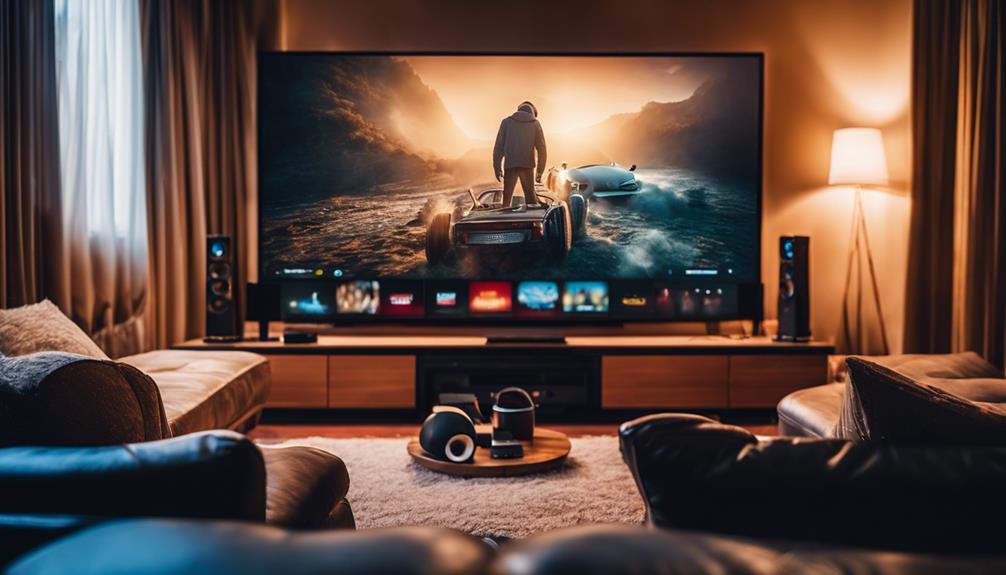
An immersive home cinema experience hinges on choosing the right audio solutions to complement your projector and elevate sound quality beyond built-in speakers. Built-in projector speakers often lack the depth and power you need for a truly cinematic experience.
Instead, consider these options to enhance your audio setup:
- External Sound Systems: Investing in a soundbar or surround sound system can greatly improve your sound quality. These devices typically offer richer audio and more immersive effects compared to standard projector speakers.
- Audio Outputs: Check for audio output options on your projector. Look for HDMI eARC for high-quality audio pass-through, or verify it has a 3.5 mm audio output or Bluetooth connectivity for seamless integration with various audio devices.
- Dolby Atmos Compatibility: For an advanced audio experience, choose a projector that supports Dolby Atmos. This technology requires specific hardware to fully utilize its capabilities, enhancing your overall home cinema setup.
Choose the Right Screen

Choosing the right screen can greatly enhance your home cinema experience by improving picture quality and guaranteeing the best viewing angles. When selecting a projector screen, consider screen types, sizes, and room lighting.
Here's a quick overview of essential factors:
| Screen Type | Best For | Key Features |
|---|---|---|
| Fixed-Frame | Permanent setups | High durability |
| Pull-Down | Versatile spaces | Convenient storage |
| Motorized | Automated setup | Remote control |
| Ambient-Light-Rejecting | Bright rooms | Absorbs ambient light, enhances contrast |
| Portable/Tripod | On-the-go viewing | Easy to transport |
For ideal brightness, choose a screen suited for your projector's ANSI lumens output. A minimum of 1,000 ANSI lumens is recommended for a 100-inch screen in bright settings. If your room has ambient lighting, gray screens can improve color contrast, while white screens maximize brightness. Remember to account for throw distance when determining screen sizes. Selecting the right projector screen guarantees you enjoy vivid visuals and an engaging home cinema experience.
Frequently Asked Questions
How to Pick a Home Movie Projector?
To pick a home movie projector, start by setting your budget. Then, consider your room size, lighting, and desired resolution. Finally, check connectivity options to guarantee compatibility with your devices for a seamless experience.
What Makes a Good Home Theatre Projector?
So, you think any projector will do? A good home theater projector needs Full HD or 4K resolution, brightness over 2,000 lumens, high contrast ratios, vibrant colors, and solid connectivity to truly shine in your setup.
How Many Lumens Should a Home Theater Projector Have?
For a home theater in a dark room, you'll want at least 1,500 to 2,000 ANSI lumens. In brighter spaces, aim for 2,500 to 3,000 lumens to guarantee clear, vibrant images.
What to Look for in a Projector for Home Use?
When diving into the world of projectors, think of vibrant colors splashing across your wall. You'll want brightness, resolution, throw distance, and connectivity options that dance together, crafting a visual experience that captivates your senses.
Conclusion
As you commence your quest for the perfect projector, think of yourself as a master artisan sculpting a masterpiece.
Each choice—be it budget, brightness, or screen—shapes the final image that dances upon your wall.
With careful consideration and a dash of creativity, you'll craft a cinematic experience that transforms your living room into a vibrant theater.
So, gather your tools and let your vision unfold; the magic of film awaits just beyond the lens!


